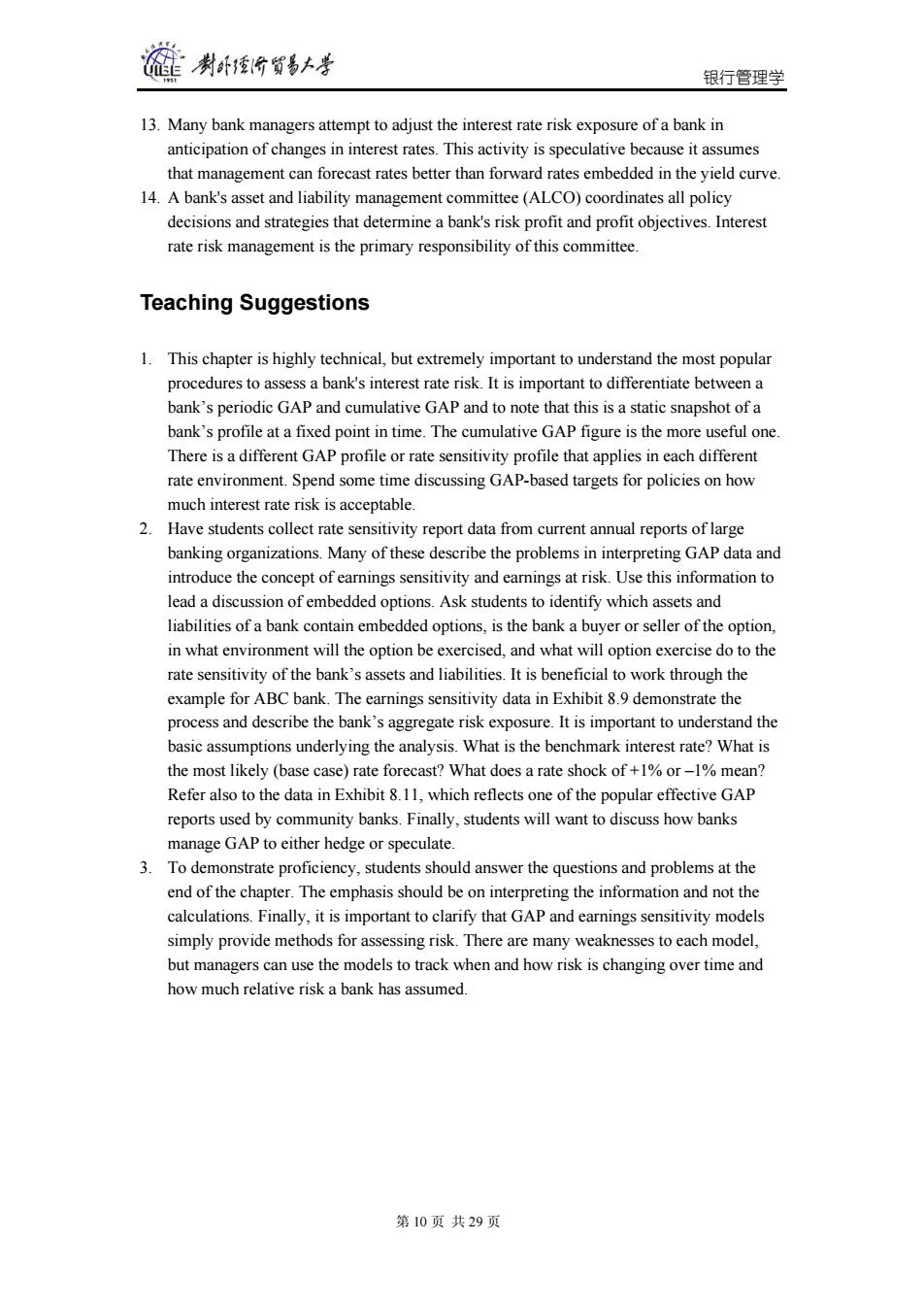正在加载图片...

制卧台贸易上兰 银行管理学 13.Many bank managers attempt to adjust the interest rate risk exposure of a bank in anticipation of changes in interest rates.This activity is speculative because it assumes that management can forecast rates better than forward rates embedded in the yield curve. 14.A bank's asset and liability management committee (ALCO)coordinates all policy decisions and strategies that determine a bank's risk profit and profit objectives.Interest rate risk management is the primary responsibility of this committee. Teaching Suggestions 1.This chapter is highly technical,but extremely important to understand the most popular procedures to assess a bank's interest rate risk.It is important to differentiate between a bank's periodic GAP and cumulative GAP and to note that this is a static snapshot of a bank's profile at a fixed point in time.The cumulative GAP figure is the more useful one. There is a different GAP profile or rate sensitivity profile that applies in each different rate environment.Spend some time discussing GAP-based targets for policies on how much interest rate risk is acceptable. 2.Have students collect rate sensitivity report data from current annual reports of large banking organizations.Many of these describe the problems in interpreting GAP data and introduce the concept of earnings sensitivity and earnings at risk.Use this information to lead a discussion of embedded options.Ask students to identify which assets and liabilities of a bank contain embedded options,is the bank a buyer or seller of the option, in what environment will the option be exercised,and what will option exercise do to the rate sensitivity of the bank's assets and liabilities.It is beneficial to work through the example for ABC bank.The earnings sensitivity data in Exhibit 8.9 demonstrate the process and describe the bank's aggregate risk exposure.It is important to understand the basic assumptions underlying the analysis.What is the benchmark interest rate?What is the most likely (base case)rate forecast?What does a rate shock of +1%or-1%mean? Refer also to the data in Exhibit 8.11,which reflects one of the popular effective GAP reports used by community banks.Finally,students will want to discuss how banks manage GAP to either hedge or speculate. 3.To demonstrate proficiency,students should answer the questions and problems at the end of the chapter.The emphasis should be on interpreting the information and not the calculations.Finally,it is important to clarify that GAP and earnings sensitivity models simply provide methods for assessing risk.There are many weaknesses to each model, but managers can use the models to track when and how risk is changing over time and how much relative risk a bank has assumed. 第10页共29页银行管理学 第 10 页 共 29 页 13. Many bank managers attempt to adjust the interest rate risk exposure of a bank in anticipation of changes in interest rates. This activity is speculative because it assumes that management can forecast rates better than forward rates embedded in the yield curve. 14. A bank's asset and liability management committee (ALCO) coordinates all policy decisions and strategies that determine a bank's risk profit and profit objectives. Interest rate risk management is the primary responsibility of this committee. Teaching Suggestions 1. This chapter is highly technical, but extremely important to understand the most popular procedures to assess a bank's interest rate risk. It is important to differentiate between a bank’s periodic GAP and cumulative GAP and to note that this is a static snapshot of a bank’s profile at a fixed point in time. The cumulative GAP figure is the more useful one. There is a different GAP profile or rate sensitivity profile that applies in each different rate environment. Spend some time discussing GAP-based targets for policies on how much interest rate risk is acceptable. 2. Have students collect rate sensitivity report data from current annual reports of large banking organizations. Many of these describe the problems in interpreting GAP data and introduce the concept of earnings sensitivity and earnings at risk. Use this information to lead a discussion of embedded options. Ask students to identify which assets and liabilities of a bank contain embedded options, is the bank a buyer or seller of the option, in what environment will the option be exercised, and what will option exercise do to the rate sensitivity of the bank’s assets and liabilities. It is beneficial to work through the example for ABC bank. The earnings sensitivity data in Exhibit 8.9 demonstrate the process and describe the bank’s aggregate risk exposure. It is important to understand the basic assumptions underlying the analysis. What is the benchmark interest rate? What is the most likely (base case) rate forecast? What does a rate shock of +1% or –1% mean? Refer also to the data in Exhibit 8.11, which reflects one of the popular effective GAP reports used by community banks. Finally, students will want to discuss how banks manage GAP to either hedge or speculate. 3. To demonstrate proficiency, students should answer the questions and problems at the end of the chapter. The emphasis should be on interpreting the information and not the calculations. Finally, it is important to clarify that GAP and earnings sensitivity models simply provide methods for assessing risk. There are many weaknesses to each model, but managers can use the models to track when and how risk is changing over time and how much relative risk a bank has assumed